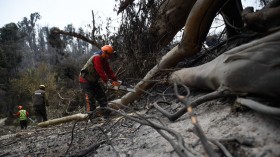"If trees could talk..." has always been a popular line among environmental advocates. One artist has now taken his own spin on that adage, asking instead, "If trees could play piano, how would it sound?" Thanks to some nifty tech and an old record player, we can find out for ourselves.
Computer wiz and artist Bartholomäus Traubeck first released the album "Years" in 2013, but people are still hearing about it now.
That's because the entire album, full of poignant and eerie piano music, was not composed by any human. Instead, it was essentially played by the life-story of trees.
If you were to take a cross-section of a tree, you would see dozens of rings, each with its own unique path and thickness. Each of these rings represent a year in a tree's life, and contain valuable information for experts, such as whether it was a good year for rain, or if the local soil has nutrients essential for keeping a forest healthy.
However, if you were to take that same cross-section and shave it down to a fraction of an inch, you'd have yourself a wooden semblance of a vinyl record. That's what Traubeck saw in tree rings, slapping one down on an old turntable in the hopes of finding some way to give these rings a "voice" we could understand. (Scroll to read on...)
[Credit: Bartholomäus Traubeck ]
The artist admitted in a past Q&A with Data Garden that he originally hoped to find a way to play the "sound" of the rings directly, translating data provided by the rings into unique sounds. He rigged a small camera up in place of the needle on a record player, and designed a program to "read" the constant images the camera digitally sent.
However, "it's just not really controllable what kind of image you get. With analog media you can just input it and just change cables and put a video signal into a stereo if you want to. But digital - it's really hard to have it make sense," he said. "I wasn't able to build anything that really worked that produces sound output. So I went with translating the visual image into piano tones which sounds nicer."
To get a really good idea of how this works you can watch Traubeck play a "record," and even try his hand at some tree-ring "scratching" here.
For more great nature science stories and general news, please visit our sister site, Headlines and Global News (HNGN).
© 2024 NatureWorldNews.com All rights reserved. Do not reproduce without permission.



![Wildfire Activity in Wet African Tropical Forests Exacerbated by Deforestation, Climate Change [Study]](https://1471793142.rsc.cdn77.org/data/thumbs/full/70409/280/157/50/40/wildfire-activity-in-wet-african-tropical-forests-exacerbated-by-deforestation-climate-change-study.jpg)

